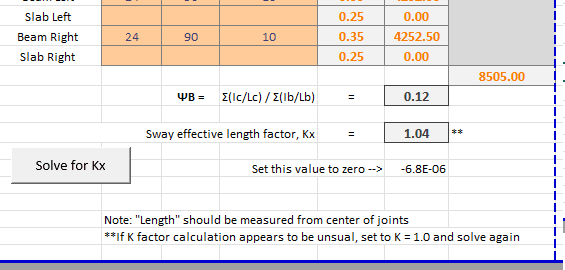import math
def K_Sway(k, Ga, Gb):
AISC_C_A_7_2 = (((Ga * Gb * math.pow(math.pi / k, 2)) - 36) / (6 * (Ga + Gb))) - (
(math.pi / k) / math.tan(math.pi / k)
)
return AISC_C_A_7_2
def K_NonSway(k, Ga, Gb):
AISC_C_A_7_1 = (
(((Ga * Gb) / 4.0) * math.pow(math.pi / k, 2))
+ (((Ga + Gb) / 2) * (1 - ((math.pi / k) / math.tan(math.pi / k))))
+ ((2 * math.tan(math.pi / (2 * k))) / (math.pi / k))
- 1
)
return AISC_C_A_7_1
def solve_K(Ga, Gb, Sway=True, tol=1e-6, imax=100):
if Sway:
ka = 1
kb = 1e20
f = K_Sway
else:
ka = 0.5
kb = 1.0
f = K_NonSway
fa = f(ka, Ga, Gb)
error = 1
esterror = 1
kc = ka
i = 0
while abs(error) >= tol and i <= imax:
kclast = kc
kc = (ka + kb) / 2
fc = f(kc, Ga, Gb)
if kc != 0:
esterror = abs((kc - kclast) / kc) * 100
if esterror < abs(fc):
error = fc
else:
error = esterror
test = fa * fc
if test < 0:
kb = kc
elif test > 0:
ka = kc
fa = fc
else:
error = 0
i += 1
return {"k": kc, "estimated error": esterror, "k_func error": fc, "iterations": i}
# ACI Column ####
b = 20
h = 28
A = b * h
Ix = b * h * h * h * (1 / 12)
Iy = h * b * b * b * (1 / 12)
rx = math.sqrt(Ix / A)
ry = math.sqrt(Iy / A)
fc = 5000
Ec = 57000 * math.sqrt(fc)
Lc = (20 - 2) * 12
EILcx = ((Ec * Ix) / Lc) * 0.7
EILcy = ((Ec * Iy) / Lc) * 0.7
# Base Joint - Foundation
# AISC Chapter C Commentary
# Pinned Foundation
Gbx = 10
Gby = 10
# Fixed Foundation
# Gbx = 1.0
# Gby = 1.0
# Top Joint
# Framing Perp. to h
bwt = 28.5 * 12
hwt = 12
Lwt = 30 * 12
Iwt = bwt * hwt * hwt * hwt * (1 / 12) * 0.25
fcwt = 5000
Ecwt = 57000 * math.sqrt(fcwt)
bet = 28.5 * 12
het = 12
Let = 30 * 12
Iet = bet * het * het * het * (1 / 12) * 0.25
fcet = 5000
Ecet = 57000 * math.sqrt(fcet)
EILbxt = ((Ecwt * Iwt) / Lwt) + ((Ecet * Iet) / Let)
Gax = EILcx / EILbxt
# Top Joint
# Framing Perp. to b
bnt = 28.5 * 12
hnt = 12
Lnt = 30 * 12
Int = bnt * hnt * hnt * hnt * (1 / 12) * 0.25
fcnt = 5000
Ecnt = 57000 * math.sqrt(fcnt)
bst = 28.5 * 12
hst = 12
Lst = 30 * 12
Ist = bst * hst * hst * hst * (1 / 12) * 0.25
fcst = 5000
Ecst = 57000 * math.sqrt(fcst)
EILbyt = ((Ecnt * Int) / Lnt) + ((Ecst * Ist) / Lst)
Gay = EILcy / EILbyt
kx = solve_K(Gax, Gbx)
kx_nonsway = solve_K(Gax, Gbx, Sway=False)
ky = solve_K(Gay, Gby)
ky_nonsway = solve_K(Gay, Gby, Sway=False)
klrx = kx["k"] * Lc * (1 / rx)
klrx_nonsway = kx_nonsway["k"] * Lc * (1 / rx)
klry = ky["k"] * Lc * (1 / ry)
klry_nonsway = ky_nonsway["k"] * Lc * (1 / ry)
Pu = 542
m1x = 0
m2x = 91.6
m1y = 0
m2y = 26
bdns = 0.505
EIxeff = 0.4 * Ec * Ix * (1 / (1 + bdns))
Pcx = (((math.pi**2) * EIxeff) / (kx["k"] * Lc) ** 2) * (1 / 1000)
Pcx_nonsway = (((math.pi**2) * EIxeff) / (kx_nonsway["k"] * Lc) ** 2) * (1 / 1000)
cmx = 0.6 - (0.4 * (m1x / m2x))
deltax = cmx / (1 - (Pu / (0.75 * Pcx)))
deltax_nonsway = cmx / (1 - (Pu / (0.75 * Pcx_nonsway)))
m2xmin = Pu * (0.6 + (0.03 * b)) * (1 / 12)
m2xmag = max(m2x, m2xmin)
mcx = max(deltax, 1) * m2xmag
mcx_nonsway = max(deltax_nonsway, 1) * m2xmag
EIyeff = 0.4 * Ec * Iy * (1 / (1 + bdns))
Pcy = (((math.pi**2) * EIyeff) / (ky["k"] * Lc) ** 2) * (1 / 1000)
Pcy_nonsway = (((math.pi**2) * EIyeff) / (ky_nonsway["k"] * Lc) ** 2) * (1 / 1000)
cmy = 0.6 - (0.4 * (m1y / m2y))
deltay = cmy / (1 - (Pu / (0.75 * Pcy)))
deltay_nonsway = cmy / (1 - (Pu / (0.75 * Pcy_nonsway)))
m2ymin = Pu * (0.6 + (0.03 * b)) * (1 / 12)
m2ymag = max(m2y, m2ymin)
mcy = max(deltay, 1) * m2ymag
mcy_nonsway = max(deltay_nonsway, 1) * m2ymag

